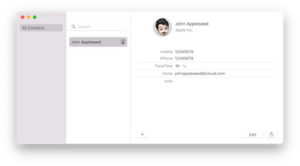Software:Address Book (application)
 Address Book 4.1 under Mac OS X | |
| Developer(s) | Apple Inc. |
|---|---|
| Stable release | 4.1.1 (695)
|
| Operating system | Mac OS X |
| Type | Software Address Book |
| License | Proprietary |
| Website | Apple: Address Book |
Address Book is an address book software application made by Apple that runs on Mac OS X. The Contacts app replaced Address Book in Mac OS X 10.8 ("Mountain Lion").
Features
- Integration with Mail, iCal, iChat, Fax, Safari, iPhone (via iTunes).
- iSync compatibility to sync contacts to phones, PDAs, iPods, and other Macs
- Exports and imports cards to and from vCard 3.0 format.
- Imports cards from LDIF, tab-delimited, and comma-separated files
- C and Objective-C API to interface with other applications.
- AppleScript support for querying, adding, modifying, and removing people and groups
- Prints labels and envelopes, mailing lists, pocket address books
- Can configure page setup and paper size before printing
- One-click automatic lookup for duplicate entries
- Change of address notification
- Contact groups
- Smart groups based on Spotlight
- Lookup address on map online
- Auto-merge when importing vCards
- Customize fields and categories
- Automatic formatting of phone numbers
- Synchronizes with Microsoft Exchange Server
- Speech recognition searching
- Address Book used to integrate Bluetooth-enabled phones (displaying incoming and missed calls, displaying incoming text messages, lets you send text messages using the phone, etc.) but these features have been entirely disabled in Mac OS 10.5 (Leopard).
- Capability to query an LDAP database containing person information
- Plugin interface allowing third-party developers to add functionality to the program
- Address Book Dashboard Widget
Description
Address Book has two viewing modes: View Card and Column, and View Card Only. The user can switch between modes with a control in the upper-left portion of the window under the close box.
In View Card and Column, the Address Book window is divided into three panes. The first pane has the title Group. This pane lists All, Directories, and each user-made group. Users can add new groups by pulling the File menu down to New Group, or typing Command-Shift-N.
When selecting All or a user-made group, the second column has the title Name. It lists the names of the people with cards in that group, or all the names if the selected group is All, in alphabetical order by first or last name, depending on user preference.
The third pane has the card corresponding to the selected name. The card can include information, some of which the user can classify into customizable categories like Home and Work. Many of the fields can have duplicate entries, for example, if the person the card describes has several email addresses. The user can edit the fields by pressing the edit button below the bottom-left of the third pane. Default fields include:
- Picture
- Name pronunciation
- First name
- Last name
- Job title
- Company
- Phone number
- Email address
- Home page
- Birthday
- Instant messaging username
- Address
- Related Names
- Note
Address Book can search LDAP directories. Users customize these in the LDAP tab of the preferences. Users search these by selecting Directories in the first pane, selecting a directory or All in the second pane, and typing their search in the search box above the top-left of the third pane. Results appear in the third pane.
Integration with other Mac OS X applications
- Address Book stores previous recipient addresses used by Mail
- URLs in Address Book cards appear in Safari's Address Book bookmarks
- Buddies in iChat can be associated with Address Book cards
- Birthdays saved in Address Book appear in iCal if enabled
Criticism
Address Book 4.1, included in Leopard, has received much criticism for the removal of the bluetooth SMS and call features.[citation needed]
External links
- Portable Address Book - Allows you to open Address Book as portable application from external drive.
- Addza Address Book: An exact Mac OS X address book clone for Microsoft Windows
- Html Dump Address Book - Exports the Address Book to HTML (for example, to print a pocket phone book)

